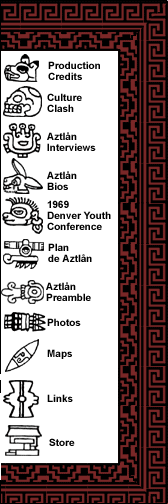

Q: How are the myths of Lake Teguayo and Aztlán
similar, and how do they arise?
A: Understanding the origins of the Aztecs is going to require figuring
out this idea of the lake that they came from, or the river that they
came from. And actually most of the cultures in the Southwest and Mexico
proper for that matter, originated along waterways. It may have been wetlands,
it may have been rivers, it may have been lakes. People did not survive,
in the pre-modern world, by being very far away from water. So you really
have to look at the water resources available in the region.
When the conquistadors first came to this area as part of the Coronado
expedition to try to find the riches of the Seven Cities of Cibolla, and
to find the origins of the Aztec in the North, they mounted [an] expedition,
and most of it went to New Mexico, that’s the famous Coronado expedition.
But a part of that expedition went up the Gulf of California and up the
Colorado River in the year 1540. When they reached the Colorado River,
they were told by the inhabitants that there was a great lake to the west,
[but the] conquistadors did not follow up on this. They didn’t go
to this lake. They returned. This was really the first expedition to the
North. It was carrying out Cortez’ promise to the king that they
would conquer the north of Mexico as well.
The idea of the lake origins ties in to the fact that the Indians along
the Colorado River told the conquistadors that there was a lake to the
west. This was probably Lake Cahuilla. It wouldn’t have been visible
from the Colorado River. It would have been about forty or fifty miles
away, but this is the lake that was being referred to. The next expedition
[that] came to the Colorado region was the Oñate expedition that
came around 1604, if I’m not mistaken. And again Oñate was
told that there was a lake to the west of the Colorado River.
There [are] other lake origin stories in the New Mexico area where people
believe that their origins were in what’s called Lake Teguayo. And
Lake Teguayo, because of its association with the idea of the lake of
Aztlán and this lake, Lake Coapalla, the conquistadors were told
about, which would have existed in California, was called the Lake of
Gold. If you look at the old maps, there’s a lake of gold there.
And that was probably based on this idea of Lake Coapalla, west of the
Colorado. The Lake Coapalla idea [claimed] that’s where people who
lived in the New Mexico Pueblos ultimately originated. Probably both are
true.
In fact, there [are] probably several different lake origins for the cultures
that established the cities of the Southwest. That originally they came
from rivers and lakes, where they had settlements, and ultimately they
created more urban settlements in the New Mexico area. So there [are]
probably two, and probably more lakes in the history of the Southwest
that are part of understanding the way these cultures developed. But the
lake in California, Lake Cahuilla, was notable in that it was the largest
lake in the entire west of the United States. West of Mexico, West of
Canada, for that matter. It was a huge lake, and would have accounted
for some settlement and some cultural evolution around that lake.
So [Aztlán is] probably not the same as Lake Teguayo, but it’s
a similar kind of thing, where people who develop settlements near lakes
and near rivers, and develop flood plain agriculture and agriculture that
could be developed around these lake areas. Ultimately they move to the
cities where they could practice more wide scale agriculture and build
the kind of architecture that survives the ages. But they all probably
started along the river or at different lakes, but Lake Teguayo and Lake
Coapalla and really Lake Cahuilla, is really what we call it now, are
probably two different ones. Lake Cahuilla is probably the California
lake, and Lake Teguayo is probably the Utah lake that is probably the
origins of some of the peoples of New Mexico.
| <<BACK |